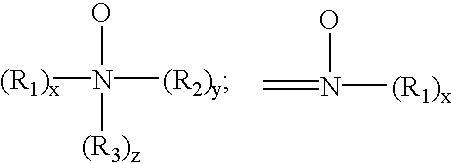Methods for laundering delicate garments in a washing machine
a washing machine and delicate technology, applied in the field of textile cleaning, can solve the problems of inconvenient and expensive, inability to wash delicate and often expensive garments, and increased cancer risk, and achieve the effects of reducing the risk of cancer, reducing the quality of dry cleaning processes, and reducing the quality of drying
- Summary
- Abstract
- Description
- Claims
- Application Information
AI Technical Summary
Benefits of technology
Problems solved by technology
Method used
Image
Examples
process example
[0271] Step 1. One or more garments to be cleaned and refreshed are selected. Stains on a garment from sources such as ink, lipstick, salad dressing, collar soil and other similar sources are then identified and selected for pretreatment. For pretreatment, localized stained areas of the garment are situated over a paper towel and are treated by directly applying about 0.5 to 5 mls (depending on the size of the stain) of the wash pretreatment product of Example I, which is gently worked into the garment using the wash pretreatment applicator. Excess liquid product is then washed off the stain with running cold tap water.
[0272] Step 2. The flexible wrap container is laid flat on an even surface such as a table or clothes dryer. A first garment such as a jacket is placed on the wrap. The sleeves and other extensions of the garment should be folded-in if necessary and none of the garment may lie outside the perimeter of the wrap. After the first garment has been laid on the wrap, the wr...
PUM
| Property | Measurement | Unit |
|---|---|---|
| shrinkage ratio | aaaaa | aaaaa |
| weight ratio | aaaaa | aaaaa |
| shrinkage ratio | aaaaa | aaaaa |
Abstract
Description
Claims
Application Information
 Login to View More
Login to View More - R&D
- Intellectual Property
- Life Sciences
- Materials
- Tech Scout
- Unparalleled Data Quality
- Higher Quality Content
- 60% Fewer Hallucinations
Browse by: Latest US Patents, China's latest patents, Technical Efficacy Thesaurus, Application Domain, Technology Topic, Popular Technical Reports.
© 2025 PatSnap. All rights reserved.Legal|Privacy policy|Modern Slavery Act Transparency Statement|Sitemap|About US| Contact US: help@patsnap.com



